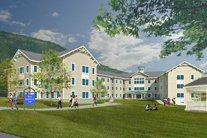Welcome to Erik's AE Senior Thesis e-Portfolio
Thesis Proposal
Thesis Proposal (Second Submission)
This proposal outlines my goal of optimizing the sustainable design of the new student housing project with respect to life cycle savings and first costs. Depth work will involve a detailed analysis of the existing geothermal heating / cooling system and a comparison against other more conventional systems. Breadth work will focus on a solar heating system for the domestic hot water, a photovoltaic system for electrical generation and storage, and the construction management issues inherent in combining all these systems into a working building.
Depth Work:
I have decided to take the geothermal heat pump system under consideration as the main depth topic of this investigation. While I have defended this system in my previous technical assignments as being the best form of heating and cooling under the circumstances, the fact remains that such a system is very expensive, and as the focus of this thesis is to be the sustainability of the building as a whole based on overall first cost and life cycle savings, a system with such a great first cost must be analyzed to see if its benefits and life cycle savings warrant its adoption.
There are three other potential types of systems which I would like to compare against the geothermal system in terms of both system costs and total building costs: conventional air-source heat pumps rejecting heat to condensing units, water-source heat pumps rejecting heat to a cooling tower, and a relatively new form of heating and cooling, variable refrigerant volume (VRV) fancoil units, which also reject heat to condensing units.
VRV was introduced to me during my internship this summer, and it was the opinion of several of the engineers there that such a system could have definite benefits once it is better understood. It implements variable flow of refrigerant to provide simultaneous heating and cooling and can also achieve far greater lift than conventional systems. During my investigation, I will be looking at Daikin VRV units, as they appear to be the forerunners of this particular form of technology. More information about VRV can be located at the company’s website as listed in my references.
Careful determination of the locations of the heat rejection apparatus would be necessary due to the aforementioned aesthetic requirements of the building, but I feel that a detailed comparison of these systems will prove to be a large deciding factor when the building is finally analyzed with regard to all proposed systems. The poor efficiencies of several of these systems might be offset by their overall savings in the long run, and I feel that in the interest of implementing other sustainable forms of design, the prohibitive first cost of the geothermal system might cause another choice to prove more favorable in this new light. Carrier’s HAP will be used to perform the necessary calculations and energy and cost analyses.
Breadth Work:
Mechanical
The current domestic hot water system utilizes natural gas as a fuel for heating the water in the hot water heater. As the university is focused on sustainable design, I propose to analyze the impacts of installing solar heat collectors at specific locations on the south-sloping roofs and using the collected energy to heat the domestic hot water.
This solar system would probably need to utilize refrigerant in the piping to keep the system operational in the winter, necessitating the addition of a heat exchanger, and analysis could prove the need for a larger tank or that a secondary form of heating might be needed for cloudy days. Using the methods and the knowledge gained from Professor Jae-Weon Jeong this semester, such a system could be accurately sized and its impact on the overall building cost determined. While the first cost of this system may make it less attractive, the energy and monetary savings could greatly outweigh the initial costs.
Lighting/Electrical
Along the same vein as the solar system mentioned above, a photovoltaic system for energy generation could also prove beneficial on this project. These PV cells would also be located at certain locations along the south-sloping roofs, and could be used to create storable electric energy, which could have various uses in such a building. Such a system could be used to charge or replace the battery backup on the emergency lighting in the building, guaranteeing greater reliability and less maintenance; however, this approach would require the wiring system of the building be analyzed in order to attach the electrical storage to the additional lighting. The electrical storage could also be used to supplement an electrical hot water heater connected to a solar heating loop on cloudy days or to defer some of the buildings electrical costs.
Once again, methods and knowledge gained from Professor Jae-Weon Jeong will be used to size this system effectively. It is my opinion that, while very innovative and sustainable, this system my also prove too costly in the short term to justify its inclusion at the end of this investigation.
Constructional
Because of all of the different systems that I am proposing and analyzing, it is going to be necessary to determine the first costs of each from a construction management point of view. The cost of installing the geothermal wells must be weighed against the costs of buying and installing condensing units or a cooling tower. Pricing must be done on both solar systems, as well as on factors such as additional wiring or the fact that the natural gas line might no longer be needed. Lead times might also be affected and must be looked at in order to determine how changes in the schedule might influence labor costs. In an analysis in which the main goal is to determine greatest overall benefit versus cost, the costs associated with construction management cannot be ignored and need to be taken into the larger scope in order to establish the most efficient, cost effective system for the new dormitory.
